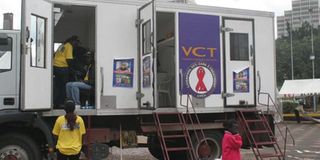Homa Bay top in new HIV cases

A mobile Voluntary Counselling and Testing (VCT) truck in Nairobi. FILE PHOTO |
What you need to know:
- Wajir had the least number of new cases, with just one fresh one in a population of 200.
- The report indicates that the number of the people on Anti-Retroviral therapy has significantly increased by over 500,000 since 2005
Over 105,500 new HIV infections were reported in the country last year, according to a survey that will be released on Wednesday.
Homa Bay had the highest new infections with 12,940 people, followed by Kisumu with 10,350. Siaya, Migori and Kisii each have 9,870, 6,790 and 4,890.
Only five counties, Homa Bay, Kisumu, Siaya, Migori and Kisii accounted for the new cases in the report, The National HIV and Aids Estimates.
The study was done by the National Aids Control Council and the National Aids and STI Control Programme.
The five counties also have the leading number of deaths linked to HIV illnesses.
ONLY A SINGLE FRESH CASE
Wajir had the least number of new cases, with just one fresh one in a population of 200.
Tana River, Marsabit, Mandera and Garissa counties each had a single infection per every 100 people.
The estimates are prepared every year by the two agencies under the Ministry of Health to gauge the impact of the epidemic nationally and in the counties.
The study shows the HIV prevalence, Aids-related deaths, the impact of care and treatment and the number of pregnant women and children affected as well as orphans.
The report indicates that the number of the people on Anti-Retroviral therapy has significantly increased by over 500,000 since 2005, as over 980,000 required treatment last year.
These are the people with CD4 counts of less than 350.
HIV among females between the ages of 15 to 24 was higher in 2013 than that in males.
“HIV cases among young females aged between 15-24 was higher than that of males in the same age group at 2.7 per cent and 1.7 per cent,” the report noted.
“Young women in this age group make up 21 per cent of all new HIV infections in Kenya,” the study further indicates.
DECLINE IN ADULTS
Despite the figures, the Ministry of Health said that there was a 15 per cent decline in the rate of HIV infection among adults aged between ages 15 to 49 in 2013 compared to the numbers in the survey done in 2000.
“There were a total of 105,000 new infections 14 years ago, compared to the 88,000 in 2013. This is due to the increased use of prevention and treatment,” the report said.
The Aids and STI control agencies attributed this to the increased use of anti-retroviral drugs, which they said, have saved more than 380,000 lives since 2009.
The ministry said that three times fewer people died of HIV in 2013, compared to the number of fatalities 10 years ago.
“Approximately 58,465 people died of Aids related complications in 2013 compared to 167,000 in 2003. “The decline is directly attributable to the wider access to free treatment” the Ministry of Health said.





